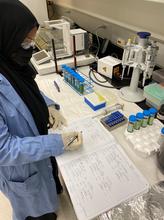Drugs and Toxicology

Rainbow Fentanyl
Goal: To both develop and facilitate the implementation of scientifically valid, robust measurement tools for the chemical characterization of drug evidence.
Why is NIST Involved in Drugs and Toxicology?
- The CDC National Center for Health Statistics reported 105452 overdose deaths in 2022, of which 79,770 were reported opioid-involved drug overdose deaths
- Drug cases are the most frequently requested type of analysis in forensic laboratories, with 575,000 drug reports in the first half of 2022, according to the NFLIS-DRUG midyear report
- The Agricultural Improvement Act of 2018 legalized hemp with less than 0.3% THC content
What is NIST doing?
Opioids and Emerging Threats – Tools and Resources
- Developing and validating new analytical tools for rapid analysis of seized drugs for accurate identification and decrease case backlogs
- Creating and curating mass spectra libraries and data interpretation tools to assist in the identification of new and emerging drugs
- Working with public health and public safety officials to create a metrology framework for near-real-time drug surveillance
Forensic Cannabis Analysis – An Integrated Measurement Service
- Developing an objective image analysis method for interpreting colorimetric test results
- Developing fundamental measurements to support breath-based detection of Cannabis Use
- Administering the Cannabis Quality Assurance Program (CannaQAP) to improve the comparability of the analytical measurements of cannabis and cannabis-derived products in forensic testing laboratories
- Developing of fit-for-purpose Cannabis analytical methods
- Developing of community-suitable Hemp Reference Material
Associated Links
- Materials Measurement Science Division
- NIST Tools for Cannabis Laboratory Quality Assurance
- Chemical Foundations for a Cannabis Breathalyzer
- Methods, Software Tools, and Resources for Forensics Laboratories with DART-MS or other AI-MS Techniques
- Development of Low-Volume Drop Blood Drug Screening Tools
- OSAC
- Center of Excellence (CSAFE)
News

Researchers Analyze THC in Breath of Cannabis Smokers
Distinguishing between recent use and past use remains an elusive goal.

Animal Tranquilizer Floods Illicit Drug Markets in Maryland
An animal tranquilizer has flooded the illicit drug market in Maryland, according to a study by NIST and the Maryland Department of Health. When injected, the tranquilizer, xylazine, causes wounds at the injection site, in some cases so severe that people need to have their arms or legs amputated.

Forensic Science Internships at NIST – A look at Cannabis Compounds
Maryam Abdur-Rahman is a Montgomery County Community College (MCCC) intern conducting forensic science research with NIST’s Cannabis team in the Chemical Sciences Division. Her job has been to help the team chemically analyze different compounds in the plant.

Safe, Efficient, Reliable: New Science in the Fight Against Killer Drugs
“A new drug might appear, then three or six months later it’s gone, replaced by something new,” said NIST chemist and program manager Marcela Najarro.
Contacts
FORENSIC SCIENCE RESEARCH Drugs and Toxicology FOCUS AREA LEAD
-
(301) 975-5395
Opioids and Emerging Threats
-
(301) 975-2093
CannaQAP
-
(301) 975-3438
-
(301) 975-3120
Cannabis Breathalyzer
-
(303) 497-4968
-
(303) 497-5614

